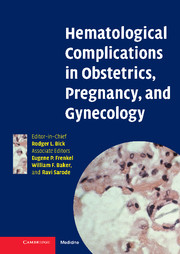Book contents
- Frontmatter
- Contents
- List of contributors
- Preface
- 1 Disseminated intravascular coagulation in obstetrics, pregnancy, and gynecology: Criteria for diagnosis and management
- 2 Recurrent miscarriage syndrome and infertility caused by blood coagulation protein/platelet defects
- 3 Von Willebrand disease and other bleeding disorders in obstetrics
- 4 Hemolytic disease of the fetus and newborn caused by ABO, Rhesus, and other blood group alloantibodies
- 5 Hereditary and acquired thrombophilia in pregnancy
- 6 Thromboprophylaxis and treatment of thrombosis in pregnancy
- 7 Diagnosis of deep vein thrombosis and pulmonary embolism in pregnancy
- 8 Hemorrhagic and thrombotic lesions of the placenta
- 9 Iron deficiency, folate, and vitamin B12 deficiency in pregnancy, obstetrics, and gynecology
- 10 Thrombosis prophylaxis and risk factors for thrombosis in gynecologic oncology
- 11 Low molecular weight heparins in pregnancy
- 12 Post partum hemorrhage: Prevention, diagnosis, and management
- 13 Hemoglobinopathies in pregnancy
- 14 Genetic counseling and prenatal diagnosis
- 15 Thrombocytopenia in pregnancy
- 16 Neonatal immune thrombocytopenias
- 17 The rational use of blood and its components in obstetrical and gynecological bleeding complications
- 18 Heparin-induced thrombocytopenia in pregnancy
- 19 Coagulation defects as a cause for menstrual disorders
- Index
- Plate section
- References
11 - Low molecular weight heparins in pregnancy
Published online by Cambridge University Press: 01 February 2010
- Frontmatter
- Contents
- List of contributors
- Preface
- 1 Disseminated intravascular coagulation in obstetrics, pregnancy, and gynecology: Criteria for diagnosis and management
- 2 Recurrent miscarriage syndrome and infertility caused by blood coagulation protein/platelet defects
- 3 Von Willebrand disease and other bleeding disorders in obstetrics
- 4 Hemolytic disease of the fetus and newborn caused by ABO, Rhesus, and other blood group alloantibodies
- 5 Hereditary and acquired thrombophilia in pregnancy
- 6 Thromboprophylaxis and treatment of thrombosis in pregnancy
- 7 Diagnosis of deep vein thrombosis and pulmonary embolism in pregnancy
- 8 Hemorrhagic and thrombotic lesions of the placenta
- 9 Iron deficiency, folate, and vitamin B12 deficiency in pregnancy, obstetrics, and gynecology
- 10 Thrombosis prophylaxis and risk factors for thrombosis in gynecologic oncology
- 11 Low molecular weight heparins in pregnancy
- 12 Post partum hemorrhage: Prevention, diagnosis, and management
- 13 Hemoglobinopathies in pregnancy
- 14 Genetic counseling and prenatal diagnosis
- 15 Thrombocytopenia in pregnancy
- 16 Neonatal immune thrombocytopenias
- 17 The rational use of blood and its components in obstetrical and gynecological bleeding complications
- 18 Heparin-induced thrombocytopenia in pregnancy
- 19 Coagulation defects as a cause for menstrual disorders
- Index
- Plate section
- References
Summary
The pathophysiology of the thrombotic process is multicomponent and involves blood, vascular system, humoral mediators and target sites. Furthermore, the intiating event and the site of thrombogenesis play a key role in the overall pathogenesis. The process of thrombogenesis is depicted in Figure 11.1. Initially, vascular injury results in the localized alterations of the vessels, generation of tissue factor, and subsequent activation of platelets. Activated cells mediate several direct or signal transduction induced processes resulting in the activation of platelets. Cellular activation also results in the release of various mediators which amplify vascular spasm and the coagulation process. Adhesion molecules, cytokines, oxidative stress and flow conditions signficantly contribute to the ischemic and occlusive outcome. Drugs that target various sites of the activation process have been developed to control thrombotic events. Because of the coupled pathophysiology, a drug that targets a single site may not be able to produce the desired therapeutic effects. Furthermore, many of these mediators produce localized actions at cellular and subcellular levels. Feedback amplification processes also play an important role in the pathology of these disorders and interruption of these pathways can be a therapeutic goal. This understanding has led to the concept of polytherapy in the management of thrombotic disorders.
Pregnancy and thrombosis
Pregnancy is associated with a hypercoagulable state that can lead to thrombosis and thromboembolism. The risk of venous thromboembolism (VTE) in pregnancy is approximately six times higher than in non-pregnant women.
- Type
- Chapter
- Information
- Publisher: Cambridge University PressPrint publication year: 2006



